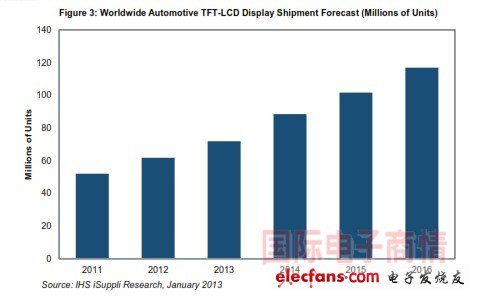According to IHS iSuppli's mobile and emerging display and technical service report data, as more and more are used in mid-range and economy cars, the shipment of in-vehicle car displays will nearly double from 2012 to 2016. It is estimated that the shipments of automotive displays will reach 116.8 million in 2016, a 89% increase from the 61.7 million in 2012. During the above forecast period, the annual shipment growth rate will be double digits, ranging from 14.9% to 23.1%. In 2015, shipments will exceed the 100 million mark. These products are full-color TFT-LCD displays. Global automotive TFT-LCD display shipment forecast (unit: million units) In 2012, about 37% of car display shipments came from the 7.x-inch field, ranking first in the market. Most car manufacturers such as BMW, Volkswagen, Toyota, Ford and General Motors choose this size for their car navigation and infotainment systems. Platforms using a 7-inch center console display include General Motors IntelliLink, Nissan navigation system, and Toyota Premium HDD navigation. The 7-inch touch monitor may also be the main size used by the emerging dual-monitor console trend. InniTI LE and Acura RLX and many other concept models use dual displays in the center console. Due to steady growth in demand, it is expected that 7.x inches will maintain a leading position in the field of automotive displays in the next four years. Last year ’s second largest car display size was 3.x inches, with a 19% market share. 3.x-inch displays are usually used in two ways: either as a multi-display panel on the mid-range car dashboard, or as a simple infotainment display for many economical cars. Compared with other car categories, the center console display has a lower share of economy cars, but the overall market size of economy cars is huge, which helps 3.x-inch displays to achieve good performance. 7.x and 3.x inches together account for 56% of the automotive display market, and the remaining share is occupied by 6.x, 4.x and 8.x inch displays. The United States requires that all cars be equipped with rear-view cameras by 2014. This will be an important factor driving the growth of automotive displays. It is expected that the United States will account for 21% of global automotive display sales by then. This instruction to install a rear-view camera is to help expand the driver's field of vision, thereby improving car safety. The directive will mainly affect economic vehicles. The average sales price of the 3.x-inch display is low, and it is expected to be the first choice for economy cars, while the larger size displays from 6.x to 8.x are more likely to appear in mid-range cars. Manufacturers start to pay attention to the field of automotive displays Compared with other display applications, the automotive display market is highly customized and requires different display specifications to match the brand value of the car. Design and production usually have a long life cycle, and automotive displays must support a five-year automotive production period, including support guarantees and SKUs for additional years. Display suppliers are not satisfied with selling displays used in consumer electronics products such as TVs, mobile phones, tablet computers, and digital cameras. Currently, there is increased interest in entering the automotive market because automotive replaceable standard parts have a supply chain life of up to 10 years. Japanese manufacturers such as Sharp and JDI were major auto display suppliers in 2012. The car display products of these two companies provide a high degree of customization, and can also meet the various technical requirements of car manufacturers and car display system integrators. Overall, because Japanese manufacturers use a large amount of third- and fourth-generation factories' production capacity for the production of automotive displays, they have succeeded in completing large orders. The rapid growth of this market is also attracting other suppliers to join. Taiwan suppliers such as AUO and CMI, as well as Korean display suppliers such as LG Display, are allocating factory capacity to produce more automotive displays. IHS iSuppli believes that in the next five years, competition in the automotive display market is expected to increase, and suppliers must keep up with changes in market dynamics and gain insight into key trends so that they can seize emerging business opportunities.
Standard Recovery Stud Diode are mainly used for rectifying and switching
It has positive pressure reduction (0.4v -- 1.0v), short reverse recovery time (2-10ns nanosecond), large reverse leakage current, low pressure resistance, generally lower than 150V, and is used in low voltage situations.
Diodes are electronic devices that have two electrodes that allow only a single current to flow in a single direction.Varicap bond (bond) is an electronic adjustable capacitor.Most diodes have a current orientation that we call reading "rectifier".The most common function of a diode is to allow only the current to pass in one direction (called forward bias) and to block in the opposite direction (called reverse bias).
Standard Recovery Stud Diode Standard Recovery Stud Diode,Standard Recovery Diode,400V Standard Recovery Diode,Stud Diode YANGZHOU POSITIONING TECH CO., LTD. , https://www.yzpst.com